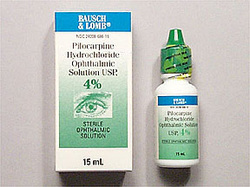Pharmacology definition - Pilocarpine

Pilocarpine
Pilocarpine is useful in treating patient with wide angle glaucoma and narrow angle glaucoma.
Pilocarpine will react on the muscarinic receptors (M1,M2 and M3) as muscarinic receptor agonist. Pilocarpine will acts mostly on the muscarinic 3 receptor / M3 receptor. Pilocarpine is applied topically on to the eyes. Pilocarpine will cause contraction of the sphincter muscle of the iris which lead to the opening of the canal of schelmm which is useful in treating patient with narrow angle glaucoma.
Pilocarpine may also cause the contraction of the ciliary muscle which cause the opening of the trabecular meshwork and increase in the outflow of the aqueous humor. This is useful in treating patient with wide angle glaucoma.
Pilocarpine may carry its own side effects such as sweating and salivation.
Pilocarpine is useful in treating patient with wide angle glaucoma and narrow angle glaucoma.
Pilocarpine will react on the muscarinic receptors (M1,M2 and M3) as muscarinic receptor agonist. Pilocarpine will acts mostly on the muscarinic 3 receptor / M3 receptor. Pilocarpine is applied topically on to the eyes. Pilocarpine will cause contraction of the sphincter muscle of the iris which lead to the opening of the canal of schelmm which is useful in treating patient with narrow angle glaucoma.
Pilocarpine may also cause the contraction of the ciliary muscle which cause the opening of the trabecular meshwork and increase in the outflow of the aqueous humor. This is useful in treating patient with wide angle glaucoma.
Pilocarpine may carry its own side effects such as sweating and salivation.
